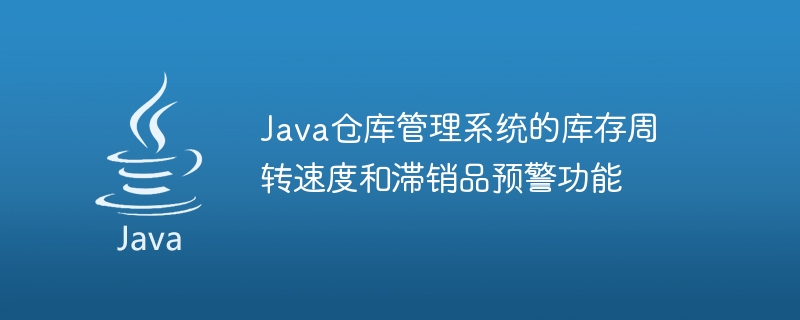

Inventory turnover speed and slow-moving goods early warning function of Java warehouse management system
The length is limited to 1500 words
1. Introduction
With the rapid development of e-commerce and supply chain management, warehouse management has become more and more important. An efficient warehouse management system can help companies increase inventory turnover speed and reduce the risk of slow-moving goods. In this article, we will introduce how to use the Java programming language to develop a warehouse management system with inventory turnover speed and slow-moving goods warning functions, and provide some specific code examples.
2. Inventory turnover speed
Inventory turnover speed is one of the important indicators to measure the efficiency of warehouse management. It can help companies evaluate inventory utilization and turnover efficiency, and formulate corresponding purchase and sales strategies. In the warehouse management system, we can calculate the inventory turnover speed through the following steps:
When developing a warehouse management system, we can use the Java programming language to write an inventory turnover speed calculation function. The following is a sample code:
public double calculateInventoryTurnover(double beginInventory, double endInventory, double salesCost) {
double averageInventory = (beginInventory + endInventory) / 2;
double inventoryTurnover = salesCost / averageInventory;
return inventoryTurnover;
}3. Slow-moving product warning function
Slow-moving products refer to products that have not been sold within a period of time. For warehouse managers, slow-moving items can take up warehouse space and increase inventory costs. In order to reduce the risk of slow-moving goods, we can add a slow-moving product early warning function to the warehouse management system. The specific steps are as follows:
Adding a slow-moving product early warning function to the Java warehouse management system can improve the controllability of slow-selling risks. The following is a sample code:
public void alertObsoleteProducts(List<Product> products, int threshold) {
SimpleDateFormat dateFormat = new SimpleDateFormat("yyyy-MM-dd");
Date currentDate = new Date();
for(Product product : products) {
Date lastSaleDate = product.getLastSaleDate();
long daysSinceLastSale = (currentDate.getTime() - lastSaleDate.getTime()) / (1000 * 60 * 60 * 24);
if(daysSinceLastSale > threshold) {
String message = "Product " + product.getName() + " has been obsolete for " + daysSinceLastSale + " days.";
sendAlertMessage(message);
}
}
}This is a simple sample code for the slow-moving product warning function. In actual applications, more details and logic may need to be considered.
Conclusion
This article introduces how to use the Java programming language to develop a warehouse management system with inventory turnover speed and slow-moving goods early warning functions, and provides some specific code examples. Inventory turnover speed and slow-moving product warning functions are very important parts of modern warehouse management. I hope these sample codes can help readers understand and implement these functions. Of course, the actual warehouse management system also needs to consider more actual situations and needs. Here we only introduce some basic concepts and methods. Hope this article is helpful to readers.
The above is the detailed content of Inventory turnover speed and slow-moving goods early warning function of Java warehouse management system. For more information, please follow other related articles on the PHP Chinese website!
 setInterval
setInterval
 What is the shortcut key for brush size?
What is the shortcut key for brush size?
 Detailed explanation of linux dd command
Detailed explanation of linux dd command
 How to solve disk parameter errors
How to solve disk parameter errors
 What are the SEO diagnostic methods?
What are the SEO diagnostic methods?
 What are the css3 gradient properties?
What are the css3 gradient properties?
 The most promising coin in 2024
The most promising coin in 2024
 What does pycharm mean when running in parallel?
What does pycharm mean when running in parallel?
 The difference between PD fast charging and general fast charging
The difference between PD fast charging and general fast charging




